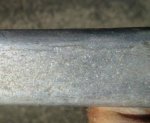- Joined
- Oct 30, 2003
- Messages
- 18,382
- Location
- Santa Maria, California
- Aircraft
- Givens Predator
- Total Flight Time
- 2600+ in rotorcraft
I use quality spherical rod ends in my rotor control system and advise others to do the same.
The specifications for even the poorest quality spherical rod ends exceed the loads in the control system by a very wide margin. A ¼ 28 commercial grade Heim brand will handle 1,700 pounds of static load. Most people use at least 5/16 24 for a static load of 2,500 pounds.
If the spherical rod end is not captured on both sides I like to have some sort of retention like a large washer incase the spherical bearing fails.
As with all things that rotate I feel there should be a secondary form of retention on the bolt that goes through the ball. I prefer mechanical but fresh elastic stop nuts will do the job.
All of the spherical rod ends I have seen fail broke because their maximum misalignment was exceeded and they were repeatedly put in bending.
If I find a bent one in the control system I replace it before the next flight and correct whatever caused it to bind.
In a crash it is possible to create loads that will pull a spherical rod end apart.
I have found high misalignment spherical rod ends for special applications.
There have been times I have made special coned washers so that the body of the spherical rod end doesn’t bind.
I recently inspected a client’s aircraft and found the control rod ends exceeding the maximum misalignment and were in bending.
It is my observation that even the highest quality spherical rod ends will fail if they are put in bending and may in fact fail sooner in bending because they are usually harder.
The way I check the spherical rod ends for bending is see if they still have play throughout their travel while someone slowly operates the cyclic through its full travel in all directions.
If they get tight anywhere the flexing of the mast and other parts of the frame will probably be enough to put them in bending. It doesn’t take much bending to cause a failure.
Even on a well-designed control system it may be possible to put the spherical rod ends in bending by how the jam nuts are tightened. I watch how it works and pay close attention to this flight critical part.
I have found high misalignment spherical rod ends for special applications.
The specifications for even the poorest quality spherical rod ends exceed the loads in the control system by a very wide margin. A ¼ 28 commercial grade Heim brand will handle 1,700 pounds of static load. Most people use at least 5/16 24 for a static load of 2,500 pounds.
If the spherical rod end is not captured on both sides I like to have some sort of retention like a large washer incase the spherical bearing fails.
As with all things that rotate I feel there should be a secondary form of retention on the bolt that goes through the ball. I prefer mechanical but fresh elastic stop nuts will do the job.
All of the spherical rod ends I have seen fail broke because their maximum misalignment was exceeded and they were repeatedly put in bending.
If I find a bent one in the control system I replace it before the next flight and correct whatever caused it to bind.
In a crash it is possible to create loads that will pull a spherical rod end apart.
I have found high misalignment spherical rod ends for special applications.
There have been times I have made special coned washers so that the body of the spherical rod end doesn’t bind.
I recently inspected a client’s aircraft and found the control rod ends exceeding the maximum misalignment and were in bending.
It is my observation that even the highest quality spherical rod ends will fail if they are put in bending and may in fact fail sooner in bending because they are usually harder.
The way I check the spherical rod ends for bending is see if they still have play throughout their travel while someone slowly operates the cyclic through its full travel in all directions.
If they get tight anywhere the flexing of the mast and other parts of the frame will probably be enough to put them in bending. It doesn’t take much bending to cause a failure.
Even on a well-designed control system it may be possible to put the spherical rod ends in bending by how the jam nuts are tightened. I watch how it works and pay close attention to this flight critical part.
I have found high misalignment spherical rod ends for special applications.





